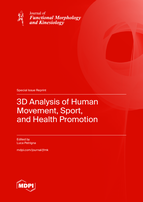3D Analysis of Human Movement, Sport, and Health Promotion
A special issue of Journal of Functional Morphology and Kinesiology (ISSN 2411-5142). This special issue belongs to the section "Physical Exercise for Health Promotion".
Deadline for manuscript submissions: closed (31 August 2023) | Viewed by 32420
Special Issue Editor
Interests: motion capture; kinesiology; stereophotogrammetry; movement analysis; postural evaluation; markerless; gait analysis; health monitoring; rasterstereography; gesture recognition
Special Issues, Collections and Topics in MDPI journals
Special Issue Information
Dear Colleagues,
The 3D analysis of human movement aims to objectively and quantitatively assess motor functions and alterations. It is a valuable method for sport scientists, coaches, and clinicians to evaluate sport performance, common movements, and alterations. The feasibility of 3D analysis is spreading because it can be adopted both in a laboratory setting or directly in the field, in static or dynamic conditions, and physiological or pathological movements. This evaluation technique can be adopted for many people, including children, adolescents, adults, and older people, whether sedentary or athletes, healthy or motor impairments subjects. The noninvasiveness of this method fosters its applicability in all contexts. Being radiation-free does not determine any adverse effect on the person; furthermore, it does not require long preparation procedures or a specific clinician’s ability to individuate anatomic landmarks correctly. Several research fields use 3D analysis to evaluate full-body skeletal tracking, gesture recognition, or face tracking, employing its use in gait analysis, rasterstereography, and posturography with promising results. Different innovative methodologies are being developed to analyze 3D measures, such as multicamera systems, machine learning methods, or specific software for computers and smartphones. This special issue aims to collect studies adopting 3D analysis in different contests with particular attention to health promotion. Contributions are invited from groups active in this field of research.
Dr. Luca Petrigna
Guest Editor
Manuscript Submission Information
Manuscripts should be submitted online at www.mdpi.com by registering and logging in to this website. Once you are registered, click here to go to the submission form. Manuscripts can be submitted until the deadline. All submissions that pass pre-check are peer-reviewed. Accepted papers will be published continuously in the journal (as soon as accepted) and will be listed together on the special issue website. Research articles, review articles as well as short communications are invited. For planned papers, a title and short abstract (about 100 words) can be sent to the Editorial Office for announcement on this website.
Submitted manuscripts should not have been published previously, nor be under consideration for publication elsewhere (except conference proceedings papers). All manuscripts are thoroughly refereed through a single-blind peer-review process. A guide for authors and other relevant information for submission of manuscripts is available on the Instructions for Authors page. Journal of Functional Morphology and Kinesiology is an international peer-reviewed open access quarterly journal published by MDPI.
Please visit the Instructions for Authors page before submitting a manuscript. The Article Processing Charge (APC) for publication in this open access journal is 1600 CHF (Swiss Francs). Submitted papers should be well formatted and use good English. Authors may use MDPI's English editing service prior to publication or during author revisions.
Keywords
- motion capture
- kinesiology
- stereophotogrammetry
- movement analysis
- postural evaluation
- markerless
- gait analysis
- health monitoring
- rasterstereography
- gesture recognition







